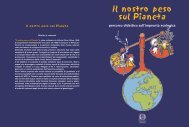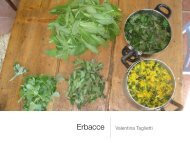Myanmar Protected Areas: Context, Current Status ... - Istituto Oikos
Myanmar Protected Areas: Context, Current Status ... - Istituto Oikos
Myanmar Protected Areas: Context, Current Status ... - Istituto Oikos
Create successful ePaper yourself
Turn your PDF publications into a flip-book with our unique Google optimized e-Paper software.
Executive summary<br />
This publication presents the information<br />
collected on <strong>Myanmar</strong> protected areas (PAs),<br />
with the objective of mobilising national<br />
and international support for cost-effective<br />
initiatives, innovative approaches and<br />
targeted research implemented by non-<br />
State actors in collaboration with authorities<br />
and communities in sites needing priority<br />
conservation actions. <strong>Myanmar</strong> presents a<br />
great variety of habitats and ecosystems,<br />
from snow-capped mountains to coral reefs,<br />
supporting a rich biodiversity. Demographic<br />
and socio-economic pressures have been<br />
identified as the main causes of environmental<br />
degradation and biodiversity loss. The environmental protection framework set up by <strong>Myanmar</strong> during<br />
the 1990s shows legal and institutional constraints. Environmental laws are very sector-specific and<br />
institutions lack capacity and resources for their implementation. Nonetheless, progress has been made<br />
towards the integration of environmental issues in the national development process and stakeholders<br />
consultation mechanisms have increased coordination in planning. A small but growing number of<br />
<strong>Myanmar</strong> environmental NGOs has emerged and is playing an important role to facilitate environmental<br />
education, research work and co-management of resources at local level.<br />
In <strong>Myanmar</strong> there are currently 43 officially-recognised PAs but so far the information on their status<br />
has been poor, scattered and not updated. A comprehensive datasheet was prepared to organize in a<br />
systematic way the information collected on natural resources, management, staff and infrastructure,<br />
tourism, land use and human activities and research, following internationally approved criteria<br />
and standards. Existing information was first retrieved from authorities, organisations and academic<br />
institutions; then it was verified and integrated through field visits and meetings with stakeholders for<br />
30 PAs while maps were produced for all 43 PAs. All information is organised in a database available to<br />
stakeholders. <strong>Myanmar</strong> PA system currently covers 7.3 % of the country. Despite the long coastline there<br />
are only 4 marine protected areas and there is little capacity to conserve and manage marine resources.<br />
The number and size of PAs have increased over the years but also some terrestrial habitat types are still<br />
underrepresented, in particular beach and dune, mangrove and swamp forests. Human encroachment<br />
in PAs is common and requires intervention to limit it, however in most cases the conservation status is<br />
considered to be within an acceptable range of variation. Only half of the PAs have partial biodiversity<br />
inventories and an operational or management plan including actions that are regularly implemented<br />
despite inadequate human, technical and financial resources. Seventeen PAs are only paper parks.<br />
Religious tourism and ecotourism exist in many PAs but most lack the resources and skills to invest in<br />
effective tourism management and consequently forego the opportunity to generate revenues from<br />
it. Scientific research has been conducted in 28 PAs by national and international organisations and<br />
universities without a coordinated research programme.<br />
Two PAs were selected for in-depth studies: Lampi Island Marine National Park and Rakhine Yoma<br />
Elephant Range Wildlife Reserve. Lampi Island Marine National Park (MNP) is the only MNP in <strong>Myanmar</strong><br />
and the only protected area of the Myeik archipelago. Very little information was available on this area<br />
and it had not been updated since 1995. Collecting data on this area was considered very important<br />
to raise the awareness of <strong>Myanmar</strong> and international stakeholders on the importance of conserving<br />
the archipelago and involving the local heterogeneous population composed by indigenous minorities<br />
and migrants from different areas of <strong>Myanmar</strong> in participatory resources management. The rapid<br />
<strong>Myanmar</strong> <strong>Protected</strong> <strong>Areas</strong><br />
assessment survey conducted in January<br />
2009 confirmed the great value of the<br />
archipelago in terms of biological and cultural<br />
attributes, threatened by the uncontrolled<br />
and rapid increase of human settlements<br />
and activities. Field surveys identified 195<br />
species of plants of the evergreen forest, 63<br />
mangroves and associates, 19 mammals,<br />
228 birds, 19 reptiles, 10 amphibians. Among<br />
the marine resources, 333 plankton species,<br />
L.Beffasti<br />
73 seaweeds, 11 seagrass, 50 gastropods, 42<br />
crabs, 41 bivalves, 35 sea cucumbers and 42<br />
fish species. 29 species are new records for<br />
<strong>Myanmar</strong> (1 phytoplankton, 7 zooplanktons,<br />
2 seagrasses, 1 mangrove tree, 7 fishes, 3 amphibians, 8 birds). Furthermore, the issues of the Salone (or<br />
Moken) people were collected, as well as those of other human settlements in the area. As population<br />
grows inside and outside the park, the natural resources are increasingly threatened by unsustainable<br />
use. Consultations among authorities, organisations and communities were initiated to launch the<br />
participatory development of a management plan for the MNP to ensure the incorporation of the needs<br />
and aspirations of local communities along with conservations goals. The Rakhine Yoma Elephant Range<br />
Wildlife Reserve encompasses a great variety of habitats supporting high biodiversity and many endemic<br />
and endangered species, but it is one of the most encroached PAs. Local communities are dependent on<br />
natural resources for their livelihoods and are often damaging the environment and using its resources<br />
without due regard to sustainability. A GIS database was set up to propose a preliminary classification of<br />
vegetation types, which was then verified through a ground-truthing campaign. Ten vegetation classes<br />
were identified and land cover maps produced. The vegetation change between 1974 and 2003 was<br />
analysed showing the conversion of natural forests to agricultural areas and vice-versa. The main finding<br />
is the invasion of Melocanna bambusoides in the area, probably subsequent to forest fires and shifting<br />
cultivation practices; creation of a buffer zone and implementation of environmental education and<br />
sustainable development activities are crucial to prevent the degradation of the last patches of forest.<br />
New data and maps on vegetation change and land use can thus support sustainable development<br />
plans and activities, and raise awareness on the current threats to this ecosystem.<br />
According to project findings, <strong>Myanmar</strong> PA system should be reviewed giving emphasis to the<br />
management objective and strategically expanded to address gaps in coverage of globally threatened<br />
species, underrepresented mangrove and marine habitats, Key Biodiversity <strong>Areas</strong> and wildlife corridors.<br />
It is crucial to improve coordination between Forest Department (FD) and other departments and<br />
it is also advisable to pilot joint governance initiatives at local level in collaboration with NGOs and<br />
communities. While public awareness needs to be raised, from top to grass root level, on the role and<br />
benefits of protected areas in order to achieve comprehensive stakeholder participation in conservation,<br />
FD staff, especially young generations, should receive intensive training in ecology and management.<br />
This would enable the preparation of a management plan and a biodiversity inventory for every PA<br />
to be organised in a central database to facilitate coordination and information sharing at national<br />
and international level, also to develop coordinated research programmes. The human impacts of PAs<br />
should be measured in order to identify and implement innovative poverty reduction strategies that<br />
can contribute to meet the conservation and development goals. To ensure the allocation of adequate<br />
resources, sustainable financing mechanisms should be identified, including grants and donations and<br />
local business development.<br />
X XI






